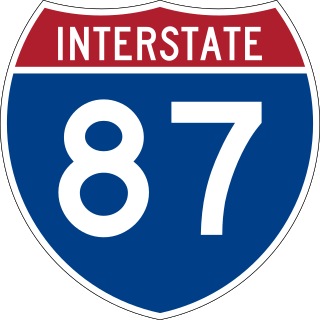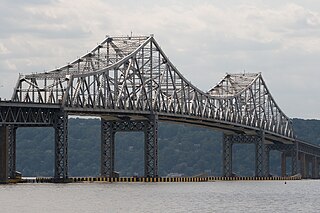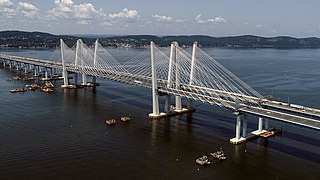
Othmar Hermann Ammann was a Swiss-American civil engineer whose bridge designs include the George Washington Bridge, Verrazzano-Narrows Bridge, and Bayonne Bridge. He also directed the planning and construction of the Lincoln Tunnel.

Interstate 87 (I-87) is a 333.49-mile-long (536.70 km) north–south Interstate Highway located entirely within the US state of New York. I-87 is the main highway that connects New York City and Montreal. The highway begins at exit 47 off I-278 in the New York City borough of the Bronx, just north of the Robert F. Kennedy Bridge and Grand Central Parkway. From there, the route runs northward through the Hudson Valley, the Capital District, and the easternmost part of the North Country to the Canada–United States border in the town of Champlain. At its north end, I-87 continues into Quebec as Autoroute 15 (A-15). I-87 connects with several regionally important roads: I-95 in New York City, New York State Route 17 near Harriman, I-84 near Newburgh, and I-90 in Albany. The highway is not contiguous with I-87 in North Carolina.

Nyack is a village located primarily in the town of Orangetown in Rockland County, New York, United States. Incorporated in 1872, it retains a very small western section in Clarkstown. The village had a population of 7,265 as of the 2020 census. It is a suburb of New York City lying approximately 15 miles (24 km) north of the Manhattan boundary near the west bank of the Hudson River, situated north of South Nyack, east of Central Nyack, south of Upper Nyack, and southeast of Valley Cottage.

Robert Moses was an American urban planner and public official who worked in the New York metropolitan area during the early to mid-20th century. Moses is regarded as one of the most powerful and influential people in the history of New York City and New York State. The grand scale of his infrastructure projects and his philosophy of urban development influenced a generation of engineers, architects, and urban planners across the United States.
The Triborough Bridge and Tunnel Authority (TBTA), doing business as MTA Bridges and Tunnels, is an affiliate agency of the Metropolitan Transportation Authority that operates seven toll bridges and two tunnels in New York City. The TBTA is the largest bridge and tunnel toll agency in the United States by traffic volume. It generated more than $2.4 billion in toll revenue from 335 million vehicles in 2023. As of 2023, its operating budget was $596 million; the budget is funded through taxes and fees.

The Governor Malcolm Wilson Tappan Zee Bridge, commonly known as the Tappan Zee Bridge, was a cantilever bridge in the U.S. state of New York. It was built from 1952 to 1955 to cross the Hudson River at one of its widest points, 25 miles (40 km) north of Midtown Manhattan, from South Nyack to Tarrytown. As an integral conduit within the New York Metropolitan Area, the bridge connected South Nyack in Rockland County with Tarrytown in Westchester County in the Lower Hudson Valley.

The Cross Island Parkway is a controlled-access parkway in New York City and Nassau County, part of the Belt System of parkways running along the perimeter of the boroughs of Queens and Brooklyn. The Cross Island Parkway runs 10.6 miles (17.1 km) from the Whitestone Expressway in Whitestone past the Throgs Neck Bridge, along and across the border of Queens and Nassau County to meet up with the Southern State Parkway, acting as a sort of separation point which designates the limits of New York City. The road is designated as New York State Route 907A (NY 907A), an unsigned reference route, and bears the honorary name 100th Infantry Division Parkway.

The Bronx–Whitestone Bridge is a suspension bridge in New York City, carrying six lanes of Interstate 678 over the East River. The bridge connects Throggs Neck and Ferry Point Park in the Bronx, on the East River's northern shore, with the Whitestone neighborhood of Queens on the southern shore.

Interstate 678 (I-678) is a north–south auxiliary Interstate Highway that extends for 14 miles (23 km) through two boroughs of New York City. The route begins at John F. Kennedy International Airport on Jamaica Bay and travels north through Queens and across the East River to the Bruckner Interchange in the Bronx, where I-678 ends and the Hutchinson River Parkway begins.

The Bear Mountain State Parkway is a state parkway located in northern Westchester County, New York, in the United States. It is an incomplete highway, with a 3.85-mile (6.20 km) western section and a 0.73-mile (1.17 km) eastern section; both sections comprise New York State Route 987H, the unsigned reference route assigned to the road by the New York State Department of Transportation (NYSDOT). Crompond Road provides a connection between the two sections. Collectively, the parkway extends from an intersection with US 6, US 9, and US 202 southeast of the Bear Mountain Bridge to an interchange with the Taconic State Parkway in Yorktown.
Gilmore David Clarke was an American civil engineer and landscape architect who designed many parks and public spaces in and around New York City.

HNTB Corporation is an American infrastructure design firm. Founded in 1914 in Kansas City, Missouri, HNTB began with the partnership made by Ernest Emmanuel Howard with the firm Waddell & Harrington, founded in 1907.
Transportation in New York is made up of some of the most extensive and one of the oldest transportation infrastructures in the country. Engineering difficulties because of the terrain of the State of New York and the unique issues of New York City brought on by urban crowding have had to be overcome since the state was young. Population expansion of the state generally followed the path of the early waterways, first the Hudson River and then the Erie Canal. Today, railroad lines and the New York State Thruway follow the same general route.

Aymar Embury II was an American architect. He is best known for commissions from the City of New York from the 1930s through to the 1950s. In this period, Embury frequently worked with Robert Moses in the latter's various city and state capacities, especially, early on, in Moses’ capacity as New York City Parks Commissioner. Many surviving examples of Embury's work are zoos, swimming pools, playgrounds, and other recreational structures in New York City parks.

The Long Island Sound link is a proposed bridge or tunnel that would link Long Island, New York, to Westchester County or Connecticut, across Long Island Sound east of the Throgs Neck Bridge. The project has been studied and debated since the mid-20th century. The most recent proposal is a tunnel between Rye, New York, on the mainland and Oyster Bay on the island. Feasibility studies for bridges and tunnels have been conducted for numerous entry points, as listed in the chart below.
Ammann & Whitney was a full-service Civil engineering firm that provided design and construction services for public and private sector projects. The firm provided new construction, renovations, adaptive reuse, historic preservation, interior design and sustainable design.
Emil H. Praeger was an American architect and civil engineer.

Weidlinger Associates, Inc., was a U.S.-based structural engineering firm that designs and rehabilitates buildings, bridges, and infrastructure and provides special services in applied science, forensics, and physical security. Weidlinger's clients include corporations, private clients, institutions, and federal, state and local governments. The firm is headquartered in New York City, with branch offices in Massachusetts, Connecticut, New Jersey, California, New Mexico, and Washington, DC. The firm also conducted business as Weidlinger Associates, Ltd., in Scotland, UK.

The Tappan Zee Bridge, officially named the Governor Mario M. Cuomo Bridge after the former New York governor, is a twin cable-stayed bridge spanning the Tappan Zee section of the Hudson River between Tarrytown and Nyack in the U.S. state of New York. It was built to replace the original Tappan Zee Bridge opened in 1955, which was located just to the south. The bridge's north span carries the northbound and westbound automobile traffic of the New York State Thruway, Interstate 87 (I-87) and I-287; it also carries a shared use path for bicycles and pedestrians. The south span carries southbound and eastbound automobile traffic.

Ferry Point Park is a 413.8-acre (167.5 ha) park in the Bronx, New York City. The park site is a peninsula projecting into the East River roughly opposite the College Point and Malba neighborhoods of Queens. The park is located on the eastern shore of Westchester Creek, adjacent to the neighborhood of Throggs Neck. The park is operated by the New York City Department of Parks and Recreation. The Hutchinson River Expressway crosses the park to the Bronx-Whitestone Bridge, splitting it into east and west sides.















